Top 10 AI Voice Agents with Multilingual Capabilities 2025
Explore the top voice AI agents with multilingual voice capabilities in 2025. Compare features, accuracy, and integrations to find the right fit for your business.

Prithvi Bharadwaj
Updated on
December 26, 2025 at 11:28 AM
The voice AI market is scaling fast. It’s set to hit USD 133.3 billion by 2034, growing at a strong 37.8% CAGR from 2024.
AI voice agents go beyond hearing words. They understand intent, respond in natural speech, and already play a big role in modern contact centers.
The challenge is language. Research shows 76% of people prefer buying in their native language. Without that, trust falls and sales slip. Multilingual voice agents bridge that gap for support, sales, and accessibility.
Companies in 2025 face growing demand for Spanish, Chinese, and more. This article explores the top voice AI agents with multilingual capabilities that meet that demand.
Key Takeaways
Multilingual voice AI is essential for global business, improving customer experience, accessibility, and sales by handling conversations in multiple languages.
Core technologies like TTS/STT, NLU/NLG, voice cloning, and large multilingual datasets make interactions natural, accurate, and context-aware.
Top AI voice agents in 2025 offer features such as real-time language detection, accent adaptation, transcription, workflow integration, and scalable enterprise support.
Choosing the right agent requires evaluating capabilities, integrations, voice quality, scalability, and how well it fits your business needs and customer interactions.
Core Technologies Behind Multilingual Voice AI
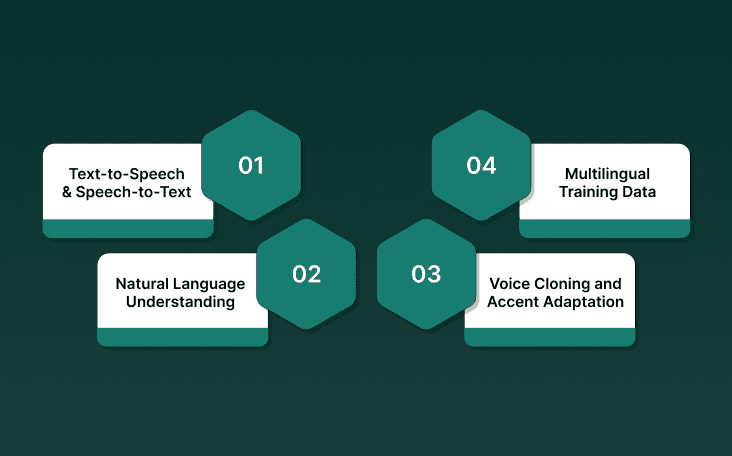
Alt text: Core Technologies Behind Multilingual Voice AI
Every multilingual voice agent runs on a few key technologies. These make sure the interaction feels natural, fast, and personal across languages. Here’s how they work:
Text-to-Speech (TTS) and Speech-to-Text (STT): TTS turns written text into spoken output, while STT converts spoken input into text with high accuracy.
Natural Language Understanding (NLU) and Natural Language Generation (NLG): NLU figures out intent behind words, and NLG produces replies that sound fluent and context-aware.
Voice Cloning and Accent Adaptation: Voice cloning builds lifelike digital voices, and accent adaptation fine-tunes tone and pronunciation for smoother conversations.
Multilingual Training Data and Model Improvements: Models trained on datasets covering over 200 languages can handle dialects, slang, and cultural nuances with better accuracy.
Also Read: 5 Best AI Text-to-Speech Tools for Celebrity Voices
With these technologies driving progress, the next step is to examine the leading AI voice agents offering multilingual reach in 2025.
10 Leading AI Voice Agents in 2025 with Multilingual Reach
AI voice agents in 2025 are no longer just about speech recognition. They’re evolving into multilingual assistants that can hold context, adapt to accents, and switch languages seamlessly.
From customer support to enterprise workflows, these tools help businesses connect with global audiences without language barriers.
Let’s take a closer look at 10 AI voice agents redefining multilingual communication.
1. Smallest.ai - Enterprise Multilingual AI Voice Agents
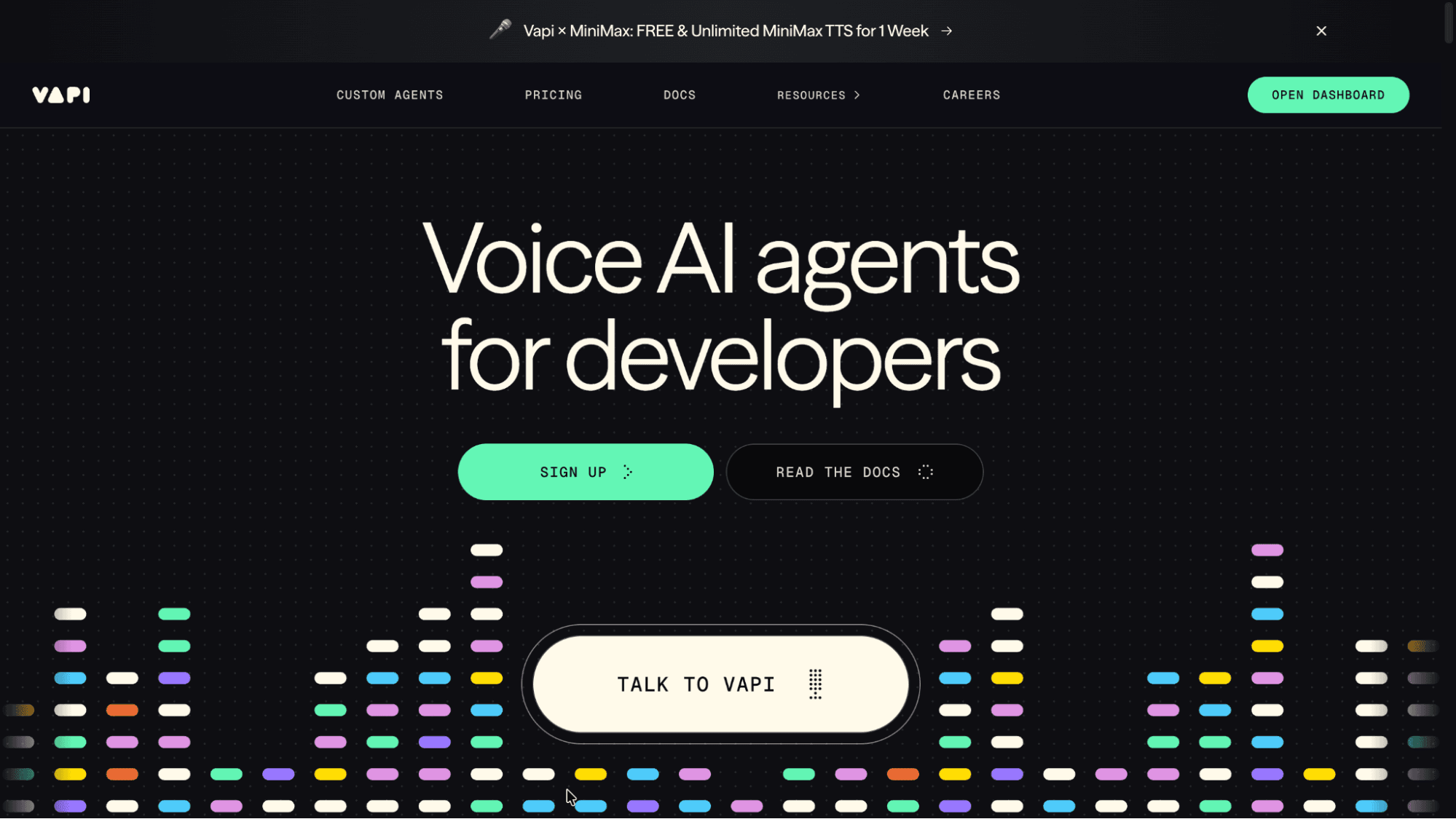
Smallest.ai delivers real-time voice agents designed for enterprise environments with proven multilingual capabilities. Its agents support 16+ languages, including English, Hindi, Tamil, Spanish, French, Arabic, and German, enabling consistent global customer interactions.
Here’s how Smallest.ai stands out:
Handles thousands of parallel calls daily with context retention.
Supports complex workflows, including customer support, sales, onboarding, and debt collection.
Processes numbers and identifiers (e.g., credit cards, phone numbers) accurately.
Deployable on cloud or on-premises infrastructure with SOC 2 Type II, HIPAA, and PCI compliance.
Developer-ready SDKs (Python, Node.js, REST APIs) for seamless integration with existing systems.
Pros:
Enterprise-ready and scalable.
High accuracy across multiple languages and accents.
Secure deployment options suitable for regulated industries.
Cons:
Primarily optimized for enterprise-scale deployments, which may be more than smaller teams require.
With its balance of multilingual reach, enterprise security, and large-scale performance, Smallest.ai sets a strong benchmark for what modern voice agents can deliver.
2. ElevenLabs
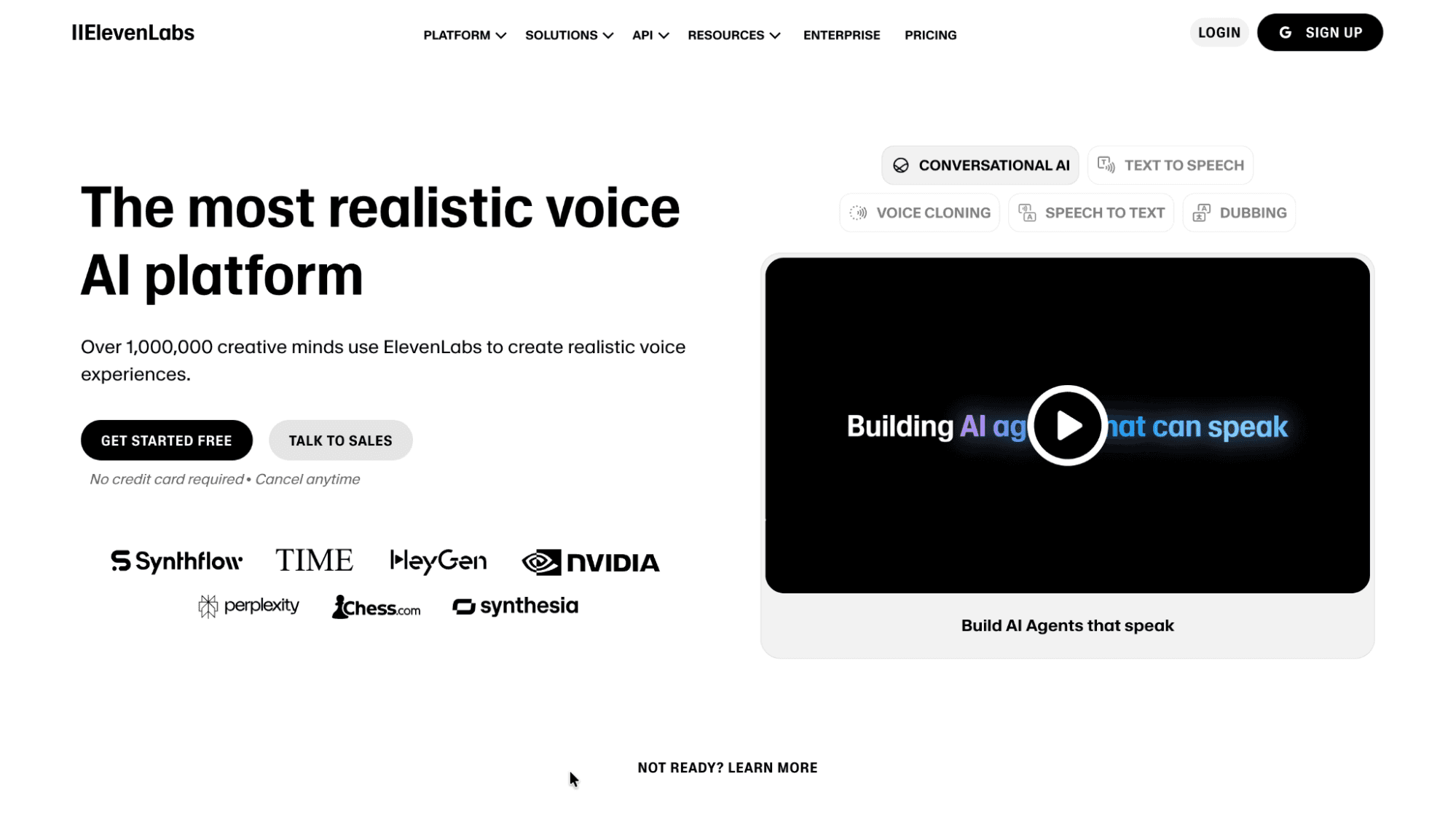
ElevenLabs is an AI voice platform that creates lifelike, expressive speech for global audiences. With support for over 70 languages and mobile access, it offers flexible, high-quality voice tools for creators and businesses.
Key Features:
Expressive, emotional voice generation.
Voice cloning from text descriptions.
ElevenReader app for text-to-speech playback.
Free tier with 10 minutes per month.
Pros:
Realistic, human-like voice quality.
Extensive language coverage.
Flexible voice customization.
Mobile accessibility for on-the-go use.
Cons:
Free tier is limited; premium plans needed for larger projects.
ElevenLabs is ideal for creators and businesses looking for realistic, flexible, and widely accessible multilingual voice solutions.
3. Vapi AI

Vapi AI detects the language a customer speaks and continues conversations seamlessly, even if multiple languages are mixed. It leverages GPT-4o for understanding intent and Deepgram Nova 2 for accurate transcription.
Key Features:
Automatic language detection.
GPT-4o powered responses.
Deepgram Nova 2 transcription.
Omnichannel support across calls, chat, and messaging.
Pros:
Smooth multilingual support.
Accurate recognition and response.
Cons:
Initial setup may be required for best performance.
Vapi AI suits businesses that need consistent support across multiple languages and channels.
4. Retell AI
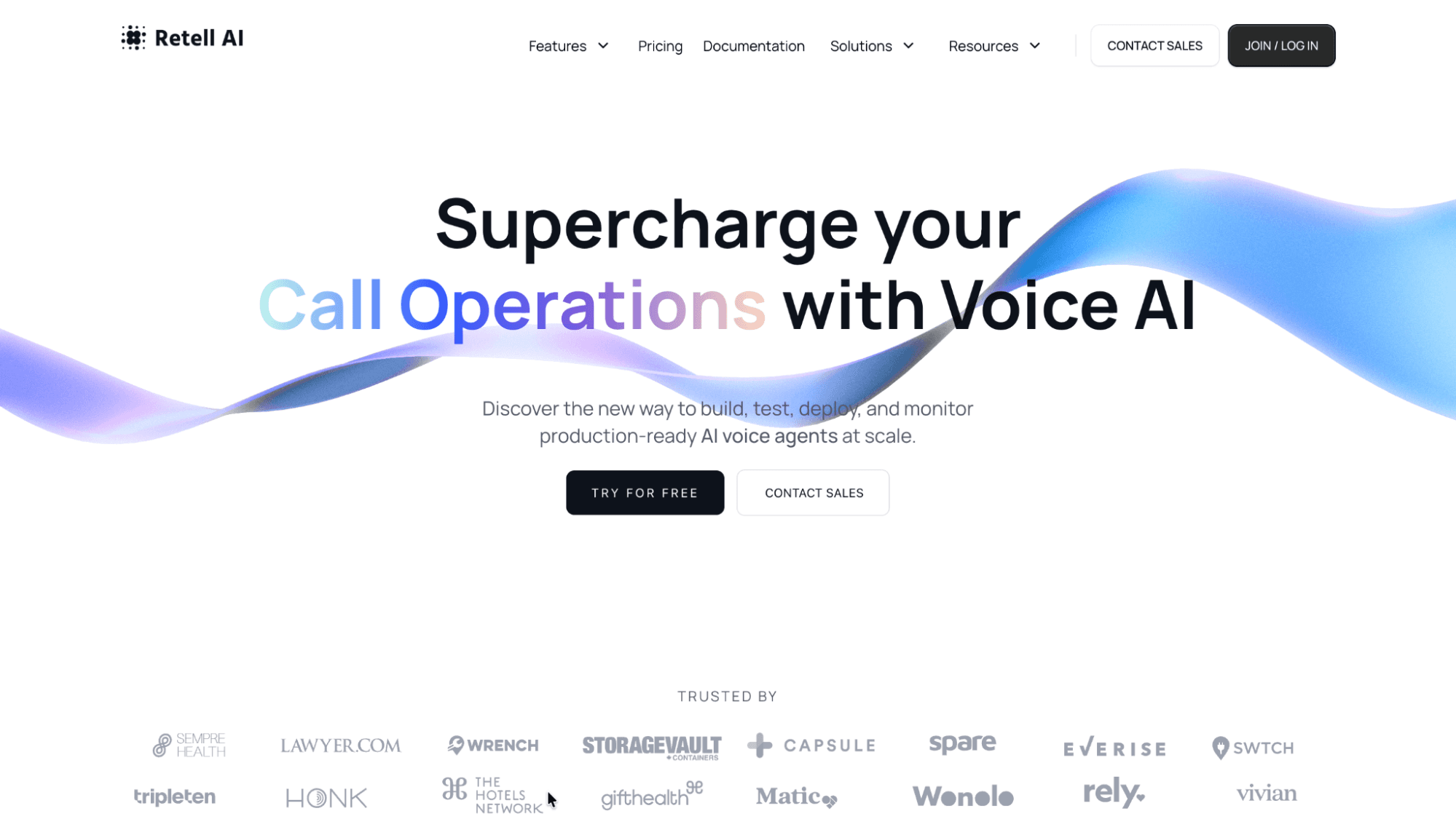
Retell AI transcribes and summarizes conversations in real time, automatically detecting the language being spoken. It can switch between languages mid-call without losing context, making it ideal for multilingual meetings and customer interactions.
Key Features:
Real-time speech-to-text conversion.
Language-specific models for accurate transcription.
Summarizes conversations for quick insights.
Integrates with various platforms for seamless workflow.
Pros:
Efficient real-time processing.
Supports multiple languages for diverse teams.
Cons:
Primarily focused on transcription and summarization, not full conversational AI.
Retell AI is perfect for teams needing quick and accurate multilingual transcriptions and summaries.
5. Cognigy
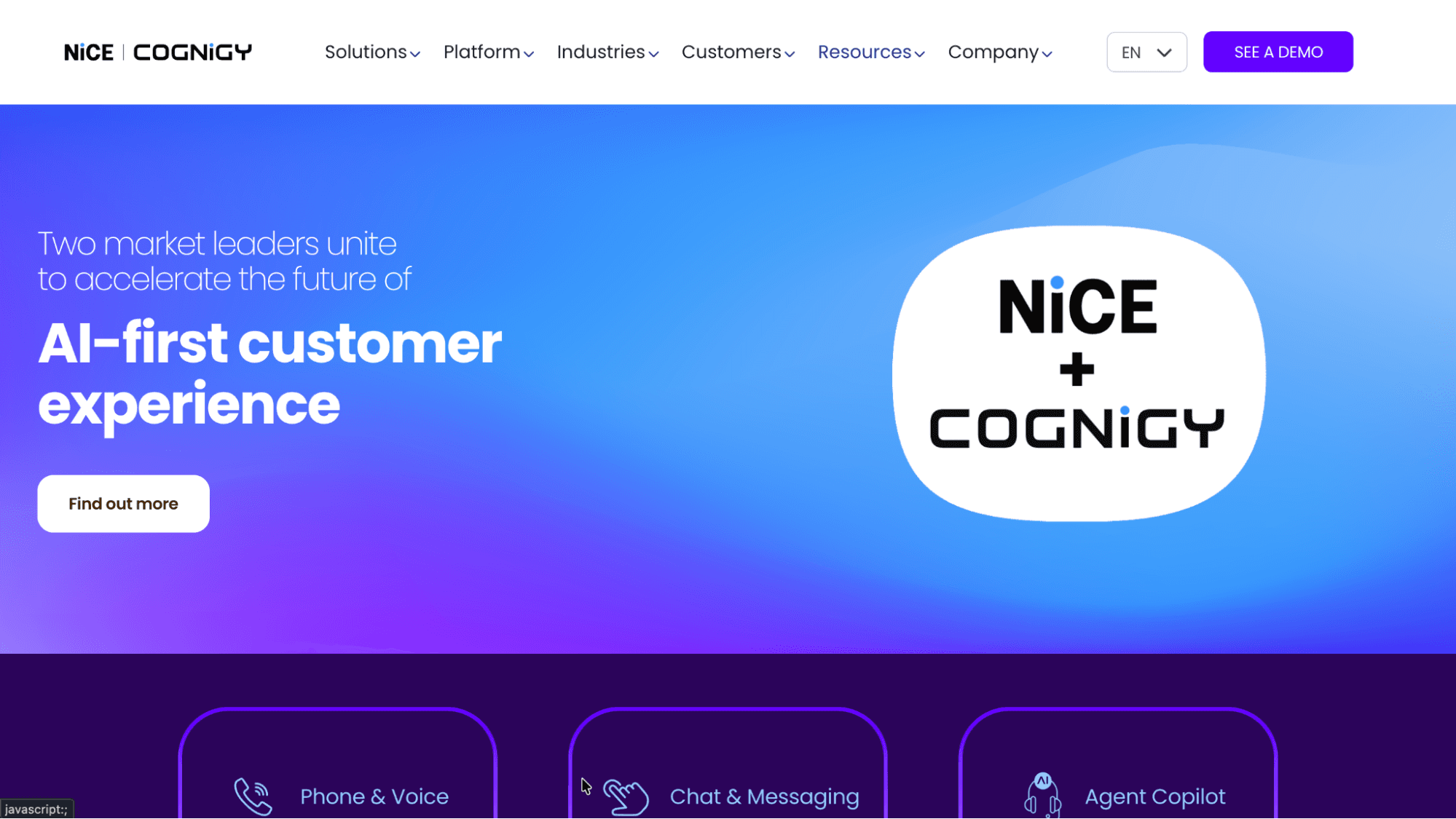
Cognigy can maintain context across long conversations, respond naturally in multiple languages, and escalate tricky queries to humans seamlessly. Businesses can deploy it on cloud or on-premises setups, and its customizable agents adapt to unique industry needs, from banking to healthcare.
Key Features:
Automated language detection and response.
Integrates with various CRM and ERP systems.
Supports complex workflows and decision trees.
Provides analytics for performance monitoring.
Pros:
Scalable solution for large enterprises.
Strong integration capabilities.
Maintains context across long multilingual conversations.
Cons:
May have a steeper learning curve for new users.
Cognigy is suited for large organizations seeking to automate multilingual customer interactions efficiently.
6. Bland AI
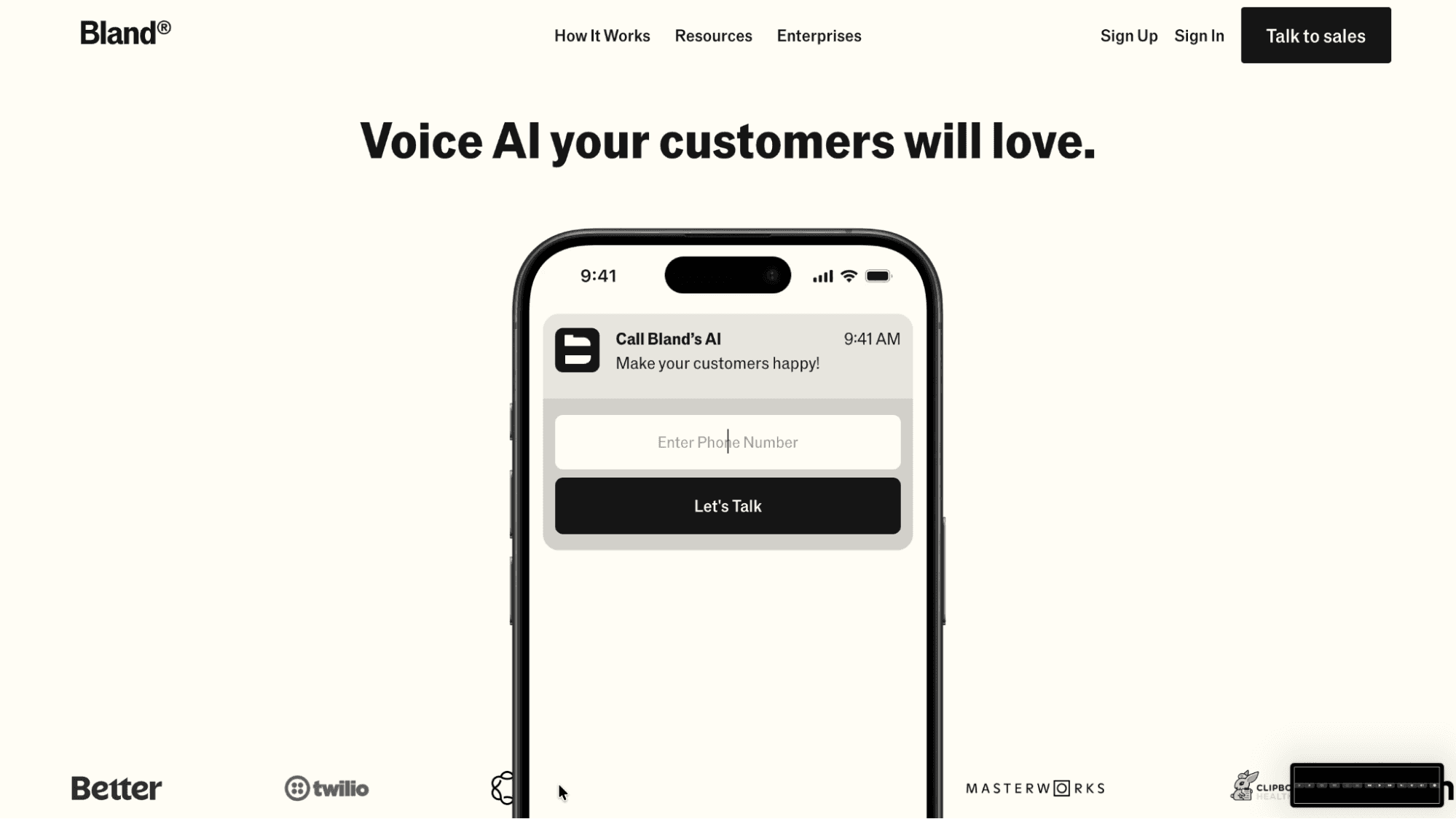
Bland AI allows businesses to create custom AI voices, enabling unique brand representation across various markets. While it primarily supports English, multilingual capabilities can be achieved through custom enterprise arrangements.
Key Features:
Custom voice creation from text prompts.
Offers 24/7 operation for continuous engagement.
Affordable pricing.
Pros:
Highly customizable voice options.
Cost-effective solution for businesses.
Cons:
Focused primarily on voice generation, not full conversational AI.
Bland AI is a great choice for businesses looking to establish a unique voice identity in multiple languages.
7. PolyAI

PolyAI builds conversational AI that can naturally switch between languages during a single conversation. It handles complex customer interactions with contextual understanding and multi-turn dialogue.
Key Features:
Automatically detects and switches languages mid-call without losing context.
Recognizes regional accents and adapts responses in real time.
Integrates seamlessly with CRMs, helpdesk tools, and telephony systems.
Tracks conversation metrics like sentiment, response accuracy, and call completion.
Pros:
Can manage complex global customer conversations reliably.
Provides deep insights for improving multilingual interactions.
Cons:
May require customization for specific business needs.
PolyAI is ideal for businesses needing a robust conversational AI solution with global language support.
8. Voiceflow
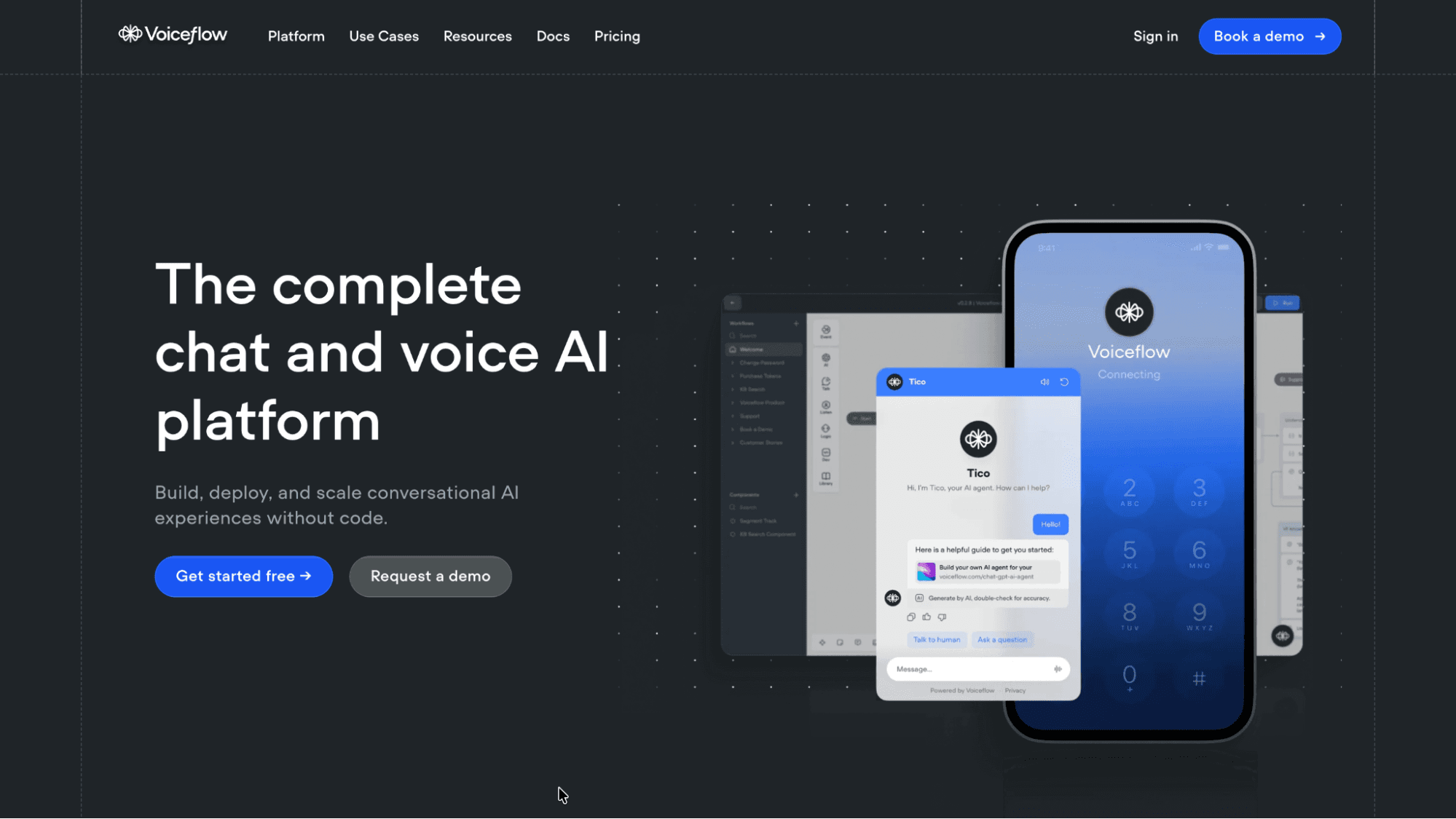
Voiceflow is a no-code platform for designing and launching voice apps on Alexa, Google Assistant, and the web. You can create apps in multiple languages, but each agent handles only one language at a time.
Key Features:
No-code drag-and-drop interface for building voice applications.
Deployment capabilities to platforms such as Alexa, Google Assistant, and web-based interfaces.
Collaboration tools to facilitate teamwork and streamline project development.
Ability to create separate flows for different languages.
Pros:
User-friendly design accessible to non-technical team members.
Facilitates rapid prototyping and deployment of voice applications.
Strong collaboration features enhance team productivity.
Cons:
Multilingual support is limited; each agent supports only a single language at a time for default entity types.
Advanced features may require a paid plan, which could be a consideration for smaller teams.
Voiceflow is ideal for teams seeking to design and deploy voice applications without extensive coding knowledge, with a focus on single-language interactions per agent.
9. Deepgram
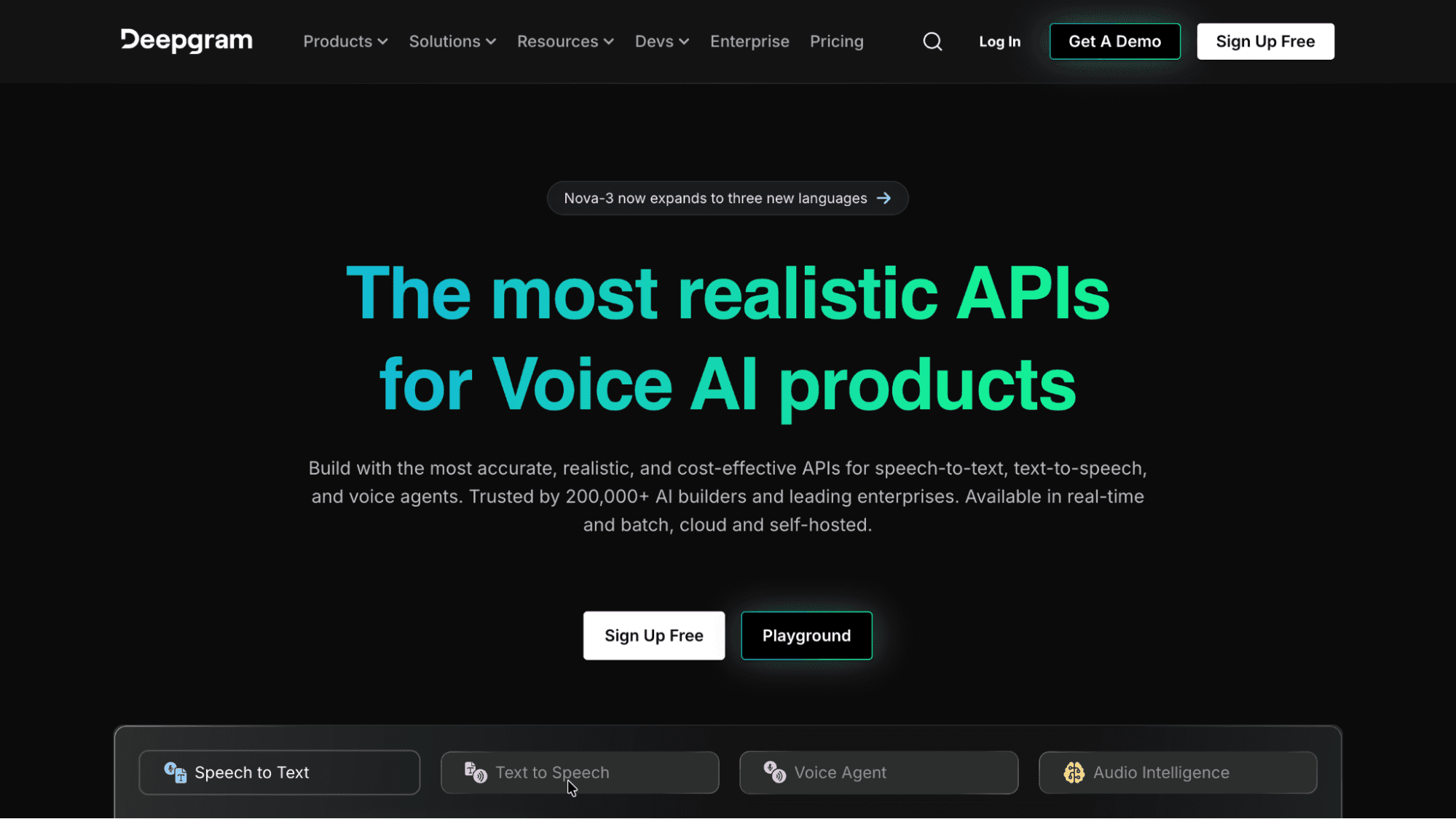
Deepgram provides AI-powered speech recognition that works accurately even in noisy environments or with multiple speakers talking at once. It automatically adapts to different accents and language shifts mid-conversation, making it ideal for call centers, meetings, and large-scale transcription projects.
Key Features:
Supports multilingual transcription.
Utilizes advanced models for accurate speech recognition.
Offers real-time transcription capabilities.
Provides APIs for integration with other platforms.
Pros:
High accuracy in diverse audio conditions.
Supports a wide range of languages.
Cons:
Primarily focused on transcription; not a full conversational AI solution.
Deepgram is ideal for applications requiring accurate multilingual speech recognition.
10. Salesforce Einstein Voice
Salesforce Einstein Voice lets users manage Salesforce using voice commands, including updating records, logging events, and capturing follow-ups. While it primarily supports English, features like Einstein Conversation Insights extend multilingual support.
Key Features:
Voice logging and automated data capture.
Multilingual support for team accessibility.
Seamless Salesforce integration.
Pros:
Directly works within Salesforce.
Multilingual features for global teams.
Cons:
Best suited for Salesforce users only.
Einstein Voice is a strong choice for enterprises seeking efficient, voice-driven CRM workflows.
Also Read: Top 11 Conversational AI Platforms In 2025
These ten voice agents show how multilingual AI is reshaping customer support, sales, and enterprise operations. With so many options on the table, the real challenge is choosing the right fit for your business needs.
How to Evaluate the Right Multilingual AI Voice Agent for Your Business
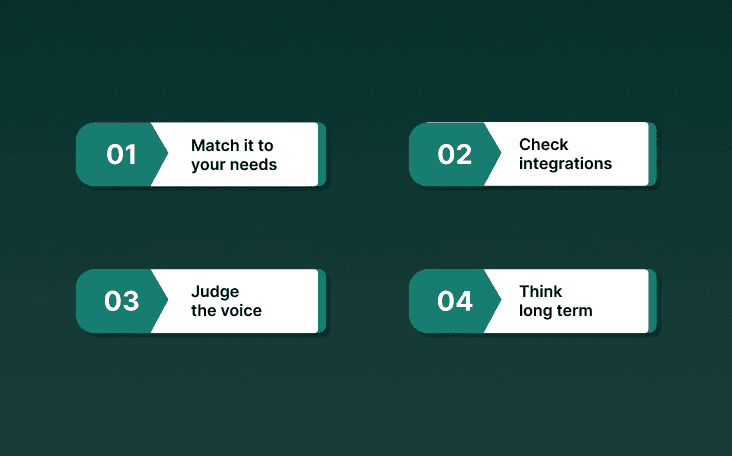
Choosing the right multilingual AI voice assistant is about fit. The best one will match your actual goals, work smoothly with your tools, sound natural, and keep growing with your business. Here’s what to look at:
Match it to your needs: Think about where you’ll use it most. For support, it should handle help requests and fix issues. For sales, it should qualify leads or book meetings. For marketing, it should trigger campaigns or share product info.
Check integrations: See if it connects with your CRM, ERP, or support platforms. Without that link, the agent might talk well but fail to update records or close out tasks.
Judge the voice: Pay attention to how natural it sounds. Look at language coverage and accent accuracy, then measure real outcomes like first-call resolution or higher satisfaction scores.
Think long term: You should ask if it can handle peak demand during launches or holidays. It should also give analytics, logs, and training tools so you can keep improving over time.
Also Read: How Voice AI Platforms Are Reducing Contact Center Expenses
In the end, the right multilingual voice agent is the one that blends into your work, supports growth, and makes every customer feel understood.
Conclusion
Reaching customers in their own language is how you win their trust. Multilingual voice agents make conversations smoother, support global growth, and keep teams running efficiently.
When choosing one, focus on what it can actually do for your business. Check capabilities, integrations, and how well it fits your support, sales, or marketing needs.
Trying demos or shortlisting options helps a lot in understanding how each tool performs in real workflows. Among these, Smallest.ai offers natural conversation with enterprise-ready multilingual support, reflecting the potential of next-generation voice AI.
Explore how AI voice agents can streamline multilingual customer interactions - try Smallest.ai today.
FAQs
1. Can multilingual AI voice agents help with accessibility for differently-abled users?
Yes. Many voice agents now include features like speech-to-text captions, simplified responses, and adjustable speaking speeds. This makes digital experiences more accessible for people with hearing or cognitive impairments.
2. How do AI voice agents handle regional slang or informal language?
Advanced models are trained on diverse speech patterns, so they can recognize regional slang, idioms, and informal phrasing. This helps interactions feel more natural and avoids miscommunication across regions.
3. Are multilingual AI voice agents useful for internal business communication?
Yes. Companies with global teams use them for internal calls, training, and knowledge sharing. Agents can translate meetings or summarize conversations, reducing language barriers between employees.
4. What role do AI voice agents play in market research?
Voice agents can gather real-time customer feedback during calls or surveys. Multilingual support ensures responses from diverse markets are captured accurately, helping businesses analyze trends across languages.
5. Can multilingual AI voice agents assist in regulatory compliance?
Yes. Agents can log all interactions, maintain transcripts in multiple languages, and track consent or disclosures. This can help businesses meet local regulations and record-keeping requirements efficiently.
The voice AI market is scaling fast. It’s set to hit USD 133.3 billion by 2034, growing at a strong 37.8% CAGR from 2024.
AI voice agents go beyond hearing words. They understand intent, respond in natural speech, and already play a big role in modern contact centers.
The challenge is language. Research shows 76% of people prefer buying in their native language. Without that, trust falls and sales slip. Multilingual voice agents bridge that gap for support, sales, and accessibility.
Companies in 2025 face growing demand for Spanish, Chinese, and more. This article explores the top voice AI agents with multilingual capabilities that meet that demand.
Key Takeaways
Multilingual voice AI is essential for global business, improving customer experience, accessibility, and sales by handling conversations in multiple languages.
Core technologies like TTS/STT, NLU/NLG, voice cloning, and large multilingual datasets make interactions natural, accurate, and context-aware.
Top AI voice agents in 2025 offer features such as real-time language detection, accent adaptation, transcription, workflow integration, and scalable enterprise support.
Choosing the right agent requires evaluating capabilities, integrations, voice quality, scalability, and how well it fits your business needs and customer interactions.
Core Technologies Behind Multilingual Voice AI

Alt text: Core Technologies Behind Multilingual Voice AI
Every multilingual voice agent runs on a few key technologies. These make sure the interaction feels natural, fast, and personal across languages. Here’s how they work:
Text-to-Speech (TTS) and Speech-to-Text (STT): TTS turns written text into spoken output, while STT converts spoken input into text with high accuracy.
Natural Language Understanding (NLU) and Natural Language Generation (NLG): NLU figures out intent behind words, and NLG produces replies that sound fluent and context-aware.
Voice Cloning and Accent Adaptation: Voice cloning builds lifelike digital voices, and accent adaptation fine-tunes tone and pronunciation for smoother conversations.
Multilingual Training Data and Model Improvements: Models trained on datasets covering over 200 languages can handle dialects, slang, and cultural nuances with better accuracy.
Also Read: 5 Best AI Text-to-Speech Tools for Celebrity Voices
With these technologies driving progress, the next step is to examine the leading AI voice agents offering multilingual reach in 2025.
10 Leading AI Voice Agents in 2025 with Multilingual Reach
AI voice agents in 2025 are no longer just about speech recognition. They’re evolving into multilingual assistants that can hold context, adapt to accents, and switch languages seamlessly.
From customer support to enterprise workflows, these tools help businesses connect with global audiences without language barriers.
Let’s take a closer look at 10 AI voice agents redefining multilingual communication.
1. Smallest.ai - Enterprise Multilingual AI Voice Agents

Smallest.ai delivers real-time voice agents designed for enterprise environments with proven multilingual capabilities. Its agents support 16+ languages, including English, Hindi, Tamil, Spanish, French, Arabic, and German, enabling consistent global customer interactions.
Here’s how Smallest.ai stands out:
Handles thousands of parallel calls daily with context retention.
Supports complex workflows, including customer support, sales, onboarding, and debt collection.
Processes numbers and identifiers (e.g., credit cards, phone numbers) accurately.
Deployable on cloud or on-premises infrastructure with SOC 2 Type II, HIPAA, and PCI compliance.
Developer-ready SDKs (Python, Node.js, REST APIs) for seamless integration with existing systems.
Pros:
Enterprise-ready and scalable.
High accuracy across multiple languages and accents.
Secure deployment options suitable for regulated industries.
Cons:
Primarily optimized for enterprise-scale deployments, which may be more than smaller teams require.
With its balance of multilingual reach, enterprise security, and large-scale performance, Smallest.ai sets a strong benchmark for what modern voice agents can deliver.
2. ElevenLabs

ElevenLabs is an AI voice platform that creates lifelike, expressive speech for global audiences. With support for over 70 languages and mobile access, it offers flexible, high-quality voice tools for creators and businesses.
Key Features:
Expressive, emotional voice generation.
Voice cloning from text descriptions.
ElevenReader app for text-to-speech playback.
Free tier with 10 minutes per month.
Pros:
Realistic, human-like voice quality.
Extensive language coverage.
Flexible voice customization.
Mobile accessibility for on-the-go use.
Cons:
Free tier is limited; premium plans needed for larger projects.
ElevenLabs is ideal for creators and businesses looking for realistic, flexible, and widely accessible multilingual voice solutions.
3. Vapi AI

Vapi AI detects the language a customer speaks and continues conversations seamlessly, even if multiple languages are mixed. It leverages GPT-4o for understanding intent and Deepgram Nova 2 for accurate transcription.
Key Features:
Automatic language detection.
GPT-4o powered responses.
Deepgram Nova 2 transcription.
Omnichannel support across calls, chat, and messaging.
Pros:
Smooth multilingual support.
Accurate recognition and response.
Cons:
Initial setup may be required for best performance.
Vapi AI suits businesses that need consistent support across multiple languages and channels.
4. Retell AI

Retell AI transcribes and summarizes conversations in real time, automatically detecting the language being spoken. It can switch between languages mid-call without losing context, making it ideal for multilingual meetings and customer interactions.
Key Features:
Real-time speech-to-text conversion.
Language-specific models for accurate transcription.
Summarizes conversations for quick insights.
Integrates with various platforms for seamless workflow.
Pros:
Efficient real-time processing.
Supports multiple languages for diverse teams.
Cons:
Primarily focused on transcription and summarization, not full conversational AI.
Retell AI is perfect for teams needing quick and accurate multilingual transcriptions and summaries.
5. Cognigy

Cognigy can maintain context across long conversations, respond naturally in multiple languages, and escalate tricky queries to humans seamlessly. Businesses can deploy it on cloud or on-premises setups, and its customizable agents adapt to unique industry needs, from banking to healthcare.
Key Features:
Automated language detection and response.
Integrates with various CRM and ERP systems.
Supports complex workflows and decision trees.
Provides analytics for performance monitoring.
Pros:
Scalable solution for large enterprises.
Strong integration capabilities.
Maintains context across long multilingual conversations.
Cons:
May have a steeper learning curve for new users.
Cognigy is suited for large organizations seeking to automate multilingual customer interactions efficiently.
6. Bland AI

Bland AI allows businesses to create custom AI voices, enabling unique brand representation across various markets. While it primarily supports English, multilingual capabilities can be achieved through custom enterprise arrangements.
Key Features:
Custom voice creation from text prompts.
Offers 24/7 operation for continuous engagement.
Affordable pricing.
Pros:
Highly customizable voice options.
Cost-effective solution for businesses.
Cons:
Focused primarily on voice generation, not full conversational AI.
Bland AI is a great choice for businesses looking to establish a unique voice identity in multiple languages.
7. PolyAI

PolyAI builds conversational AI that can naturally switch between languages during a single conversation. It handles complex customer interactions with contextual understanding and multi-turn dialogue.
Key Features:
Automatically detects and switches languages mid-call without losing context.
Recognizes regional accents and adapts responses in real time.
Integrates seamlessly with CRMs, helpdesk tools, and telephony systems.
Tracks conversation metrics like sentiment, response accuracy, and call completion.
Pros:
Can manage complex global customer conversations reliably.
Provides deep insights for improving multilingual interactions.
Cons:
May require customization for specific business needs.
PolyAI is ideal for businesses needing a robust conversational AI solution with global language support.
8. Voiceflow

Voiceflow is a no-code platform for designing and launching voice apps on Alexa, Google Assistant, and the web. You can create apps in multiple languages, but each agent handles only one language at a time.
Key Features:
No-code drag-and-drop interface for building voice applications.
Deployment capabilities to platforms such as Alexa, Google Assistant, and web-based interfaces.
Collaboration tools to facilitate teamwork and streamline project development.
Ability to create separate flows for different languages.
Pros:
User-friendly design accessible to non-technical team members.
Facilitates rapid prototyping and deployment of voice applications.
Strong collaboration features enhance team productivity.
Cons:
Multilingual support is limited; each agent supports only a single language at a time for default entity types.
Advanced features may require a paid plan, which could be a consideration for smaller teams.
Voiceflow is ideal for teams seeking to design and deploy voice applications without extensive coding knowledge, with a focus on single-language interactions per agent.
9. Deepgram

Deepgram provides AI-powered speech recognition that works accurately even in noisy environments or with multiple speakers talking at once. It automatically adapts to different accents and language shifts mid-conversation, making it ideal for call centers, meetings, and large-scale transcription projects.
Key Features:
Supports multilingual transcription.
Utilizes advanced models for accurate speech recognition.
Offers real-time transcription capabilities.
Provides APIs for integration with other platforms.
Pros:
High accuracy in diverse audio conditions.
Supports a wide range of languages.
Cons:
Primarily focused on transcription; not a full conversational AI solution.
Deepgram is ideal for applications requiring accurate multilingual speech recognition.
10. Salesforce Einstein Voice
Salesforce Einstein Voice lets users manage Salesforce using voice commands, including updating records, logging events, and capturing follow-ups. While it primarily supports English, features like Einstein Conversation Insights extend multilingual support.
Key Features:
Voice logging and automated data capture.
Multilingual support for team accessibility.
Seamless Salesforce integration.
Pros:
Directly works within Salesforce.
Multilingual features for global teams.
Cons:
Best suited for Salesforce users only.
Einstein Voice is a strong choice for enterprises seeking efficient, voice-driven CRM workflows.
Also Read: Top 11 Conversational AI Platforms In 2025
These ten voice agents show how multilingual AI is reshaping customer support, sales, and enterprise operations. With so many options on the table, the real challenge is choosing the right fit for your business needs.
How to Evaluate the Right Multilingual AI Voice Agent for Your Business

Choosing the right multilingual AI voice assistant is about fit. The best one will match your actual goals, work smoothly with your tools, sound natural, and keep growing with your business. Here’s what to look at:
Match it to your needs: Think about where you’ll use it most. For support, it should handle help requests and fix issues. For sales, it should qualify leads or book meetings. For marketing, it should trigger campaigns or share product info.
Check integrations: See if it connects with your CRM, ERP, or support platforms. Without that link, the agent might talk well but fail to update records or close out tasks.
Judge the voice: Pay attention to how natural it sounds. Look at language coverage and accent accuracy, then measure real outcomes like first-call resolution or higher satisfaction scores.
Think long term: You should ask if it can handle peak demand during launches or holidays. It should also give analytics, logs, and training tools so you can keep improving over time.
Also Read: How Voice AI Platforms Are Reducing Contact Center Expenses
In the end, the right multilingual voice agent is the one that blends into your work, supports growth, and makes every customer feel understood.
Conclusion
Reaching customers in their own language is how you win their trust. Multilingual voice agents make conversations smoother, support global growth, and keep teams running efficiently.
When choosing one, focus on what it can actually do for your business. Check capabilities, integrations, and how well it fits your support, sales, or marketing needs.
Trying demos or shortlisting options helps a lot in understanding how each tool performs in real workflows. Among these, Smallest.ai offers natural conversation with enterprise-ready multilingual support, reflecting the potential of next-generation voice AI.
Explore how AI voice agents can streamline multilingual customer interactions - try Smallest.ai today.
FAQs
1. Can multilingual AI voice agents help with accessibility for differently-abled users?
Yes. Many voice agents now include features like speech-to-text captions, simplified responses, and adjustable speaking speeds. This makes digital experiences more accessible for people with hearing or cognitive impairments.
2. How do AI voice agents handle regional slang or informal language?
Advanced models are trained on diverse speech patterns, so they can recognize regional slang, idioms, and informal phrasing. This helps interactions feel more natural and avoids miscommunication across regions.
3. Are multilingual AI voice agents useful for internal business communication?
Yes. Companies with global teams use them for internal calls, training, and knowledge sharing. Agents can translate meetings or summarize conversations, reducing language barriers between employees.
4. What role do AI voice agents play in market research?
Voice agents can gather real-time customer feedback during calls or surveys. Multilingual support ensures responses from diverse markets are captured accurately, helping businesses analyze trends across languages.
5. Can multilingual AI voice agents assist in regulatory compliance?
Yes. Agents can log all interactions, maintain transcripts in multiple languages, and track consent or disclosures. This can help businesses meet local regulations and record-keeping requirements efficiently.
Related Blogs
Lead with Precision, Speak with Purpose: What Smallest.ai Shares with Emmanuel Macron
Nov 25, 2025
Conversational AI in Customer Service: 4 Use Cases And Steps
Dec 18, 2025
The Future of AI in Customer Service: What Comes Next
Dec 18, 2025
9 Ways Contact Center AI Is Changing Customer Calls Forever
Dec 18, 2025
How Generative AI in Financial Services is Defining 2025 ROI
Dec 18, 2025


